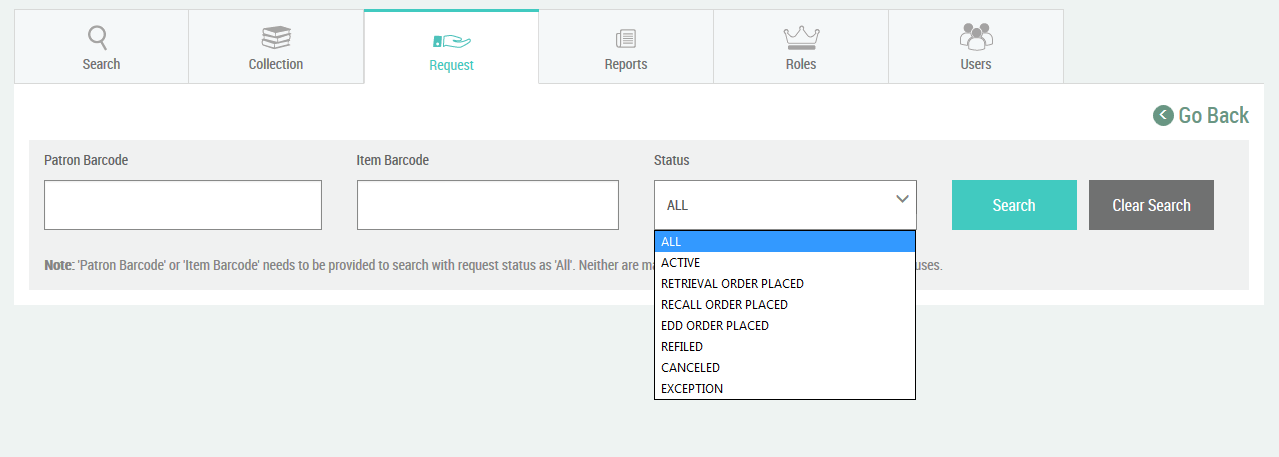The Request tab would be used primarily by the partner institution’s staff to retrieve items in ReCAP on behalf of patrons from their institution or the ReCAP staff. The tab is protected and is accessible only to those users for whom relevant roles are assigned by the administrator. A valid user will be able to access their own institution’s private items and other institution’s shared and open items for their own institution’s patrons. A valid ReCAP user will be able to access any institution’s private, open or shared items for any institution’s patron.
On clicking the Request tab in SCSB, the Create Request page is presented. It is a form which essentially takes in values such as Item Barcode, Patron Barcode, Patron Email Address, Requesting Institution, Request Type, Delivery Location and Request Notes. The Submit button submits the form and the Clear button clears values in the text fields and resets the drop downs to default.
The item barcode text field can take in multiple item barcodes separated by a comma. However, the barcodes must belong to the same bibliographic record, have the same availability status and belong to the same customer code. This is primarily to facilitate requesting multiple volumes of a Monographic set or multiple issues of a journal/serial. In cases where the item has multiple bibliographic tiles (bound-withs), the titles are concatenated and listed together delimited by pipes (||).
The patron barcode text field takes in the barcode issued by the partner institution to the patrons. This will be used to validate the patron against the Integrated Library System (ILS) of the partners. The patron email address text field takes in any email address. It will have to conform to normal email address standard and need not be the same as registered with the ILS. The user can select the requesting institution - the institution to which the patron belongs to. Since circulation staff of the partner institutions can only raise request for their own patrons, they can only select their own institution in the requesting institution drop down. However, ReCAP staff can raise request for patrons of all partner institutions and hence can choose the requesting institution from the provided options.
The request type drop down contains the various types of requests that can be placed on the item. The options are Retrieval, Recall and EDD. The retrieval request is the regular request that is raised against available items by the patrons. This will retrieve the item from GFA to be shipped to the requesting institution where a hold is placed against the patron for that item. The recall request is the request that is raised when an item that a patron is looking to borrow is currently unavailable and in a recallable state. This will place a hold against the patron for the item in the requesting institution and a recall against the patron who had borrowed it earlier.
EDD (Electronic Document Delivery) is used to deliver a scan of certain pages directly to the patron’s email box. Thus EDD gets extra fields such as the Start Page, End Page, Volume Number, Issue, Article Author and Article/Chapter Title to convey the pages that are to be scanned.
The Delivery Location drop down contains a list of delivery locations to which the item can be delivered. The list is based on the logged in user and since a partner’s circulation staff can only request items for their own institution’s patrons, the delivery location list is limited to their own institution’s locations. ReCAP staff have the ability to choose any delivery location. The Request Notes text field can be used by the user to record notes about the request.
On successful placing of request, the user is presented with a pop-up with success message along with information pertaining to the request. This information includes Item Barcode, Title, Item Owning Institution, Patron Barcode and Email Address, Requesting Institution, Request Type, Delivery Location and Notes. The pop-up screen has two buttons - Create Another Request for Same Patron and Cancel. The Create Another Request for Same Patron, as the name suggests, would re-open the Create Request page with the Patron details from this request retained.
Apart from creating requests, the Request tab also houses a screen where requests can be searched.
The search can be done based on the Patron Barcode, the Item Barcode and/or the Request Status. Either Patron Barcode or the Item Barcode needs to be provided when the request status is 'All'. Neither are mandatory when searching with other request statuses. Searching requests with request status as active retrieves records under Retrieval Order Placed, Recall Order Placed and EDD Order Placed. The Search button submits the search criteria and the Clear Search button clears the contents in the text fields. The Go Back link on the top right of the page takes the user back to the Create Request screen. The Search results follows a LIFO (Last In, First Out) ordering of results.
The Item Barcode in the search result is a hyperlink. Clicking on the Item barcode opens up the MARC content of the item.
The Request Notes is denoted by an icon in each row. Clicking on the Request Notes Icon opens up a pop-up screen with contents of the request notes for that particular request transaction.
Each row of the search results also has an icon, a grey cross with a circle around it, for the cancellation of that particular request. Clicking the button ends up canceling the request and rolls back all relevant external API calls. The user is finally notified through a pop-up screen similar to the Request Notes with the success message.
